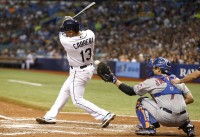Sandy Alderson
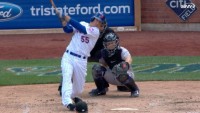
It’s funny when you think about it, but Kelly Johnson is now an ex-Met. He has returned to the Atlanta Braves where he has played most of his career. However, at least to me, in his three plus months with the team, he became a Met.
It might’ve been the circumstances in which he came to the team. The offense was historically bad. Terry Collins was trying to stick Danny Muno sized pegs into a Krakatoa sized hole. I used Krakatoa there because it was a disaster. Sandy Alderson finally responded by making a shrewd trade to bring on Johnson and Juan Uribe. In his first game as a Met, Johnson hit cleanup, played second, and did this:
The Mets who couldn’t hit their way out of a paper bag suddenly beat the Dodgers 15-2. The season had a different feel. The Mets made a move, and it was paying off. The Mets would win three straight. Everything changed when Johnson and Uribe joined the team. Everything that happened afterwards started with them.
Johnson did all he could do to help. He played every position but pitcher, catcher, and center. I appreciated it, but to me that wasn’t the moment he became a Met. That moment was after Game Two of the NLDS. He lambasted that coward. He was emotional defending his teammate, a teammate that was a New York Met.
Before the trade, I was never a fan of Kelly Johnson. The reason is as simple as it might’ve been unfair. He was an Atlanta Brave. Now, however, I see him as a New York Met even if he’s back in a Braves uniform. He was a key part of a World Series team and wish him the best of luck. When he returns to Citi Field this year, I’ll stand up and clap. He deserves it.
Thank you Kelly Johnson.
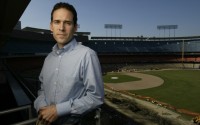
There’s been a big going around my house of late, so I thought my fever was causing me to have hallucinations when I read Paul DePodesta was leaving the Mets for the Cleveland Browns. Before I started heading to the ER, I looked to verify it, and luckily, I found this:
I have learned Paul DePodesta leaving #Mets to run the NFL Cleveland Browns as executive VP, answerable only to team owner/pres.
— Joel Sherman (@Joelsherman1) January 5, 2016
It was true, and it was an inspired hire by the Cleveland Browns. Within the baseball industry, DePodesta is a well regarded within the baseball industry. He went to Harvard, where he played both baseball and football. Despite his reputation, he cut his teeth being a scout. He would later incorporate analytical and statistical information into his scouting reports. Across the board, he’s seen as intelligent and as a hard worker. I don’t care what industry you’re in; these skills will always translate.
First, let’s address what he’s leaving behind. DePodesta was the Mets viewed by some as the successor to Sandy Alderson as the next Mets GM. While we don’t know what specifically he did during his tenure, we do know the Mets credit him with reorganizing the entire scouting department:
https://mobile.twitter.com/adamrubinespn/status/684423205981925377
As for which moves he had a direct impact on, we only have speculation. He was rumored to be a voice in support of the Mets hiring Terry Collins back in 2011. It is believed he was a proponent of keeping Lucas Duda and trading Ike Davis. He was supposedly heavily involved in the R.A. Dickey trade. As the Mets VP of Player Development and Amateur Scouting, he oversaw the draft that brought in Michael Conforto. Overall, he’s depicted as Sandy Alderson’s right hand man. As such, his fingerprints are all over the Mets.
Now, DePodesta is leaving all that to become the Browns Chief Strategy Officer. What most know about DePodesta is he worked with Billy Beane to help revolutionize baseball. I don’t think that is overstating the case when you see all teams heavily investing in analytics. Most people know this story from a little book and movie Paul DePodesta was featured.
One important note here is I implore you to read the book Moneyball for yourself. Despite what you’ve heard or seen in the movies, the book and/or the concept of Moneyball is not about OBP or advanced statistics like WAR. No, it’s about being able to locate market inefficiencies to maximize the proverbial bang for your buck.
Essentially, the concept is we can’t afford the best of the best, so what do we do to outsmart the other teams. Moneyball isn’t about saying a player like Mike Trout is the best player in the game because he does xyz. No, it’s about saying look, where our budget is, we can’t afford Mike Trout, so we need to exploit market inefficiencies to build the best team possible for the least amount of money possible. It just so happens that in the late 90’s that it was OBP. Such a fundamental misunderstanding has already lead to opinions like this:
Now we know what #Browns Haslam meant by the HC and GM will have to collaborate: it's analytics or bust. Come to interview w/ your abacus
— Mary Kay Cabot (@MaryKayCabot) January 5, 2016
I’d chalk this up to a football person making a mistake about a baseball person, but really, I see enough of the misunderstanding from supposed baseball people to know it’s a universal problem.
I think this was a terrific hire by the Browns. Football is a salary cap league. Each and every year, you’re looking at your roster. You’re crunching numbers. You’re pulling in scouting reports. You’re really just trying to figure out how you’re going to field a team within the confines of the salary cap. There is no better person for that job than Paul DePodesta.
It’s what he did in Oakland. He’s done it in New York. He knows how to find the market inefficiencies to build a complete roster. From what we’ve seen, he likes to utilize younger cheaper players at pricier positions and move them before they have outlived their value. It’s no surprise the A’s and the Mets were built upon terrific young staffs. He saved money there, and then he looked to find the players who were under market value to fill in a roster in a shoestring budget. Ultimately, isn’t that what you need your front office to do in the NFL? DePodesta’s track record matches up well with that skill set making him a good hire.
With that said, I’m not so sure this was the right move for DePodesta. First, despite the fact he has some football experience, he will always be looked at as a baseball guy. More so than anyone else his moves will be scrutinized more than anyone. The success and failure of each Browns season will be attributed to him despite the fact that he’s not the GM. He’s going to be held to a different standard.
Speaking of which, he’s going to be held to a higher standard. I don’t believe it’s hyperbole to say people are expecting a revolution. He revolutionized how front offices operate. He showed that by being ahead of the curve, any team can win. People will be expecting DePodesta to do the same with the Browns. People may not accept incremental improvements. They may not be willing to wait the five years Mets fans had to wait to see a winner.
That’s going to be difficult. One of the reasons the Browns are having problems is the division they play. The Steelers and Ravens have been traditionally run very well with very good football people. Since Marvin Lewis came aboard, the Bengals went from laughingstocks to perennnial playoff team. That is it right there in a nutshell. The best thing you can do is go get the right people and let them do their thing. Give them time to build a winner.
I’m not sure DePodesta will revolutionize the NFL. However, I believe he will do everything he can to build the Browns into a winner. He just needs to be given sufficient time to get the job done. He did it Oakland. He did it in New York. It can happen in Cleveland.
Good luck to you Paul DePodesta.
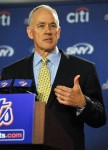
The prevailing thought is the Mets have been active this offseason making shrewd moves. Speaking of moves, are you able to name the first major league players acquired by the Mets under the Sandy Alderson regime? Good luck!
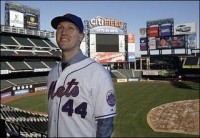
This isn’t a criticism of Sandy Alderson and his staff. This isn’t an issue of this front office being stingy or refusing to go the extra mile to get the player. It’s just that historically the Mets typically do not outbid teams when it comes to the big free agent.
That’s not to say the Mets don’t sign free agents. Obviously, they do. They’ve also overspent and spent big money on some free agents. It’s just that they don’t typically win bidding wars. They especially don’t do so when a big market team is also bidding on the same player. My personal feelings aside, I just don’t see how the Mets outbid everyone for Ben Zobrist. Here are the instances where the Wilpon led Mets outbid everyone for a high priced player:
Jason Bay
In 2009, the Mets signed Jason Bay. In some ways it could be interpreted as the Mets won a bidding war and in others it could be seen as the Red Sox moved on to other players.
Fact is the Red Sox essentially had a four year $60 million contract offer, which may or may not have been pulled due to medical concerns. You can never fully trust Boston’s statements when a player leaves. The fact is the Mets had to offer $6 million extra to bring Bay to New York. The fact also remains the Mets went after Bay instead of going after the much better and much more expensive Matt Holliday.
This isn’t about how Bay fared with the Mets as no one could have reasonable predicted what happened next. This is about the Mets outbidding the Red Sox for a player only after deciding to not even get involved in the bidding for the more expensive, better player.
Carlos Beltran
The Carlos Beltran story is an interesting one. Like Bay, it was also a move made under the Omar Minaya regime.
What’s most interesting about this was the Yankees never got involved in the bidding despite Beltran all but begging them to offer him a contract. Furthermore, the Astros had a limited window to negotiate with Beltran. Under the old free agency rules, the Astros only had until January 7th to re-sign him. If they didn’t, they were barred from re-signing him until May 1st.
The Mets went above and beyond then in Minaya’s first year as GM. The Mets signed Beltran to a then whopping seven year $119 million contract. It was a real power move that the Mets haven’t typically been the Mets strength. There was one other move in 2005 that was uncharacteristic.
Pedro Martinez
Like Bay, the Mets were able to outbid the Red Sox for Pedro Martinez because the Red Sox drew a line in the sand in a player they knew/suspected had questionable medicals. Unlike Bay, the Mets clearly outbid the Red Sox.
The Red Sox thought they had Pedro re-signed giving him the extra year he wanted. The Mets just gave that extra year and money no one thought Pedro could/should get. Like Beltran, this was part of Minaya’s reshaping of the Mets. It’s truly interesting the major deals happened in 2005 when Minaya took over the team. In some ways, it makes you question how much the Madoff Ponzi fallout affected the Mets.
Yes, it clearly limited payroll. However, after 2005, the Mets never truly went the extra mile in seeking to acquire the top free agent on the market. They were initially rebuffed by Carlos Delgado (until he was later obtained via trade). They did give a huge contract to Johan Santana in the wake of the 2007 collapse. However, that was part of a trade and not part of a free agent bidding process.
So while the Mets have at times spent money pre-Madoff, it appears the team does not usually win these free agent bidding contests. Additionally, after 2005, the team has typicall backed off the top free agent on the market that would/could fulfill a need like Jason Heyward.
In any event, it appears if history repeats itself here, the Mets will not get Zobrist. This may or may not be due to the budget. It may due more to an organizational philosophy that was in place before Sandy Alderson ever became the GM.
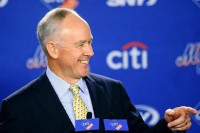
Here’s a question for you. If you had a GM that gave a bad contract to a 35 year old, forfeiting a pick in the process, and depleted it’s farm system of its top end starting pitching prospects for rentals, what would you call that GM? Apparently, you call Sandy Alderson the Executive of the Year.
Before proceeding, I’d like to note Alderson has generally done a good job with the Mets. The R.A. Dickey trade was a stroke of genius. However, that happened three years ago, and this is a 2015 award.
Alderson made two major league free agent signings for the 2015 season. The first was Michael Cuddyer. It was immediately panned by everyone. Alderson was out-maneuvered there by the Rockies of all organizations. With the Mets all but declaring they were signing David Wright‘s friend, the Rockies gave Cuddyer a qualifying offer. The Mets then gave Cuddyer a two year $21 million contract. Cuddyer was hurt, and he regressed as 35 year old players do. He’s now a $12.5 million bench player.
The other free agent deal was John Mayberry, Jr. Mayberry hit .164/.227/.318. He was released at the end of July. Overall, Alderson’s free agent acquisitions were complete busts.
His trades weren’t much better. Do you realize for a team touted with organizational starting pitching depth, Alderson depleted much of it. He traded eight minor league arms in total. For all the pitchers that were traded, Addison Reed is the only player the Mets could keep in 2016. By the way, Reed is a non-tender candidate.
Yes, the Mets made the World Series. They also lost it. For all the moves and sacrificing the future, the Mets still fell short. Further, it does not appear the moves generated enough revenue to sufficiently increase payroll. In the end, the Mets have up two big pitching prospects for rentals. If you’re saying it was worth it, I ask you if John Smoltz was worth it?
In 1987, Smoltz was traded for Doyle Alexander. Alexander went 9-0 with a 1.53 ERA for the Tigers. His fantastic run certainly mirrors the run Yoenis Cespedes had this year. Like the Mets, the Tigers won their division. Like the Mets, the Tigers didn’t win the World Series. The Tigers lost out on a Hall of Fame career. Time will only tell with Michael Fulmer. However, we do know he’s a highly rated prospect the Tigers believe can contribute very soon.
It’s the reason I said it was a bad trade from the beginning. It’s even worse when you consider the Tigers had to trade Cespedes because they were about to lose him for nothing.
Then there’s the issue of giving up another well regarded prospect in Casey Meisner for Tyler Clippard. Clippard was a rental. Yes, Clippard was terrific early on with the Mets, and he helped the Mets win the division. Addison Reed was even better, and the Mets obtained him for much less. Again, this was a bad trade.
No, Alderson won this award for his earlier work and the system built by Omar Minaya. Alderson weakened the farm system in 2015, and he may now need to trade away major league talent rather than minor leaguers to improve the team in 2016. After all his moves, the Mets still don’t have a shortstop. There may also be new holes in center and at second.
Alderson has had a good run here, but he was not good in 2015. He certainly wasn’t the best executive in 2015. Unfortunately, this should bear out in the oncoming years.
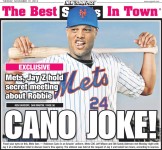
No matter how you slice and dice it, the Mets will have to replace Daniel Murphy. The Mets could stay in-house with Dilson Herrera. They could sign a free agent like Ben Zobrist. They could look to make a trade. In the year after the World Series, why not just go for it?
If you want to go for it, the player you want is Robinson Cano, who reportedly wants to leave Seattle and come back to New York. Of course, he does even if the news didn’t come from him. The Mariners are a mess. Their coaching staff ripped him on the way out the door. Safeco Field is a nightmare for hitters much in the same way Citi Field used to be. I suspect Cano meant he wanted to go to the Yankees, but who knows, maybe he’ll accept a trade to the Mets.
He can be teammates again with Curtis Granderson, who seems from afar to be a terrific teammate. He can be reunited with Kevin Long. Between that and a move out of Safeco, he may get back to or close to the statistics he used to have. He will be back in a city that he was comfortable playing. It begs the question, do you want Cano?
First off, that contract is a nightmare. He’s due $24 million each year for the next eight years. This contract carries forward into his age 40 season. He’s been accused of being a lazy player, even if the accusation was unfair. He’s been recently described as a cancer in the clubhouse. Last year, he hit .288/.334/.446. It was easily his worst season. It just so happened that this occurred when Cano may be at the end of his prime.
However, I think a return to New York to a contending team would rejuvenate his career. Cano is a career .307/.356/.494 hitter. He is an average second baseman (-0.4 average UZR per season). He still hit 21 home runs last year despite playing at Safeco. Overall, he’s been an effective hitter there, even if he was a much better hitter while with the Yankees. He’s the best second base option out there. He may still be the best second baseman in the game. He is the best second baseman available either free agency or trade. At one time the Mets were interested in signing him.
Ultimately, we know the real reason this is unrealistic. Money. Cano would not only eat up practically all of the Mets remaining budget (or put them over budget), he would also eliminate payroll flexibility. Remember, Sandy Alderson doesn’t give out second generation contracts like this. This is what makes Cano unrealistic before we even get an idea of the Mariners ask.
So while Cano would be a fit, there is no way the Mets would pursue trading for him.
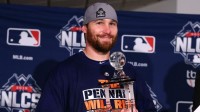
Sandy Alderson became the Mets GM prior to the 2011 season. He knew a change at second base was needed. He jettisoned Mets fans Public Enemy No. 1, Luis Castillo, and used a Rule 5 pick on Brad Emaus, who would be named the Opening Day starting second baseman.
Emaus was not good. He only hit .162/.262/.162 in 14 games. To Alderson’s credit, he cut bait when Emaus showed he couldn’t hack it. The other players that got playing time at secon that year was Justin Turner and Chin-lung Hu. That year Daniel Murphy was not part of the second base rotation. He did play 109 games that year, mostly at first, due to a season ending ankle injury to Ike Davis.
The next season, despite a decent year from Turner, the Mets went with Murphy as the starting second baseman. They have ever since. Despite a multitude of trade rumors (can be fully searched here), the Mets never traded Murphy. Despite not being an “Alderson player,” the Mets have kept him. Seemingly, they’ve grown to appreciate what he can provide to a team.
The Mets struck out on their top second base choice, and they have stuck by Murphy. He’s rewarded them with this offseason. In the end, it’s funny to think none of this would’ve been possible if Brad Emaus played better.
Sometimes it’s better to go with your second option.
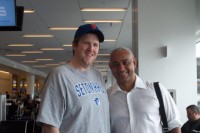
Look, this is Sandy Alderson’s team. He decided to keep the players he kept and trade the players he traded. He pulled off the trades and signed the free agents. However, he was able to do a lot of what he did because he was left with good players after Omar Minaya was terminated.
Here are the players in the 40 man roster who have a link to Omar Minaya (asterisked players are players obtained with players combined by Minaya and Alderson):
Jerry Blevins – obtained for 2010 draft pick Matt den Dekker.
Eric Campbell – 2008 draft pick.
Darrell Ceciliani – 2009 draft pick.
Travis d’Arnaud – part of the R.A. Dickey trade. Dickey was a free agent signing. Josh Thole was a 2005 draft pick. Mike Nickeas was initially obtained by trade in 2006.
Jacob deGrom – 2010 draft pick.
Lucas Duda – 2007 draft pick.
Jeurys Familia – 2007 amateur free agent signing.
Wilmer Flores – 2007 amateur free agent signing.
Erik Goeddel – 2010 draft pick.
Matt Harvey – 2010 draft pick
Dilson Herrera* – part of Marlon Byrd/John Buck trade. Buck was part of the Dickey trade (see d’Arnaud).
Juan Lagares – 2006 amateur free agent signing.
Steven Matz – 2009 draft pick.
Jenrry Mejia – 2007 amateur free agent signing.
Akeel Morris -2010 draft pick.
Daniel Murphy – 2006 draft pick.
Bobby Parnell – 2005 draft pick.
Addison Reed* – obtained in exchange for Matt Koch and Miller Diaz (signed by Mets in 2009).
Hansel Robles – 2008 amateur free agent.
Noah Syndergaard – part of Dickey trade (see d’Arnaud).
Ruben Tejada – 2006 amateur free agent.
Again, these players are in the roster because Alderson kept them. The decision of who to keep and trade is important. That is what makes them Alderson’s players and team. Additionally, while It was Alderson that hired Terry Collins, it was Minaya who brought him into the Mets organization.
However, it is important to truly acknowledge Minaya’s role, especially when he has been unfairlyand wrongly marginalized.
You see I was on the same Jet Blue flight as Omar Minaya. The photo with this post was Minaya and me in the terminal before the flight. He was accessible to Mets fans who wanted to shake his hand and take a picture. No one, and I mean no one, had the “courage” to mock him on the flight.
Additionally, this should dispel the notion that Minaya left the Mets with a depleted farm system. On the contrary, he built a strong farm system that helped make up this team. Minaya had his faults, and he probably deserved to be fired when he was. That doesn’t mean we should ignore his work.
It doesn’t mean that we shouldn’t extend our gratitude to him for what he left behind.
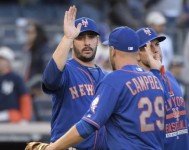
Its fitting that Matt Harvey is taking the mound today with the Mets having an opportunity to clinch a playoff spot. His absence last year was presumed to be a reason why the Mets didn’t go all out last year to try to get into the playoffs.
With Harvey healthy, along with the emergence of Jacob deGrom last year and Noah Syndergaard this year, the Mets will be going to the playoffs. No matter what you think of Harvey, and how everything has gone down, you can’t deny the wonderful season he’s had.
In his first post-Tommy John season, he’s gone 12-7 with a 2.80 ERA, 171 strikeouts (8.7 per nine), and a 1.019 WHIP in 176.2 innings. Keep in mind that today he’s going over 180 with a other start in the season before the playoffs. If the Mets go to the World Series, he may very well go over the 200-215 “loose cap” Sandy Alderdon wanted.
In any event, Harvey gave the Mets their first glimmer of hope in 2013. His absence was a dark cloud over the 2014 season. His return was a big part of the 2015 turn around. After last year, he promised the playoffs to Terry Collins:
Terry Collins said after the game @MattHarvey33 came up to him & said "We're going to do it next year." Terry added "Matt doesn't lie to me"
— New York Mets (@Mets) September 28, 2014
Harvey can now make good on that promise today. With his hard work and dedication, Harvey has earned this. There’s no one I would rather have on that mound to start the game.
Lets Go Mets!
